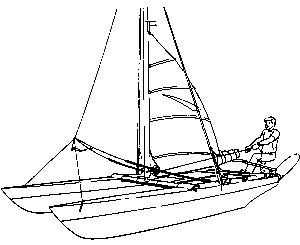Having Trouble getting it up?
This article originally appeared in the Late Summer ’97 Issue of “The Art of Dart”, UKIDA’s Class Association Newsletter.
Hoisting the mainsail on a Dart should be a simple matter of hook on and up she goes, but all too often it turns into a battle of man vs halyard. If you’ve ever suffered at the mercy of a main that wouldn’t budge, the tips below should help you rise to the occasion.
Hoisting
DO Make sure that your main halyard is made of the right stuff; it should be 5.5mm in diameter minimum, 6mm is ideal. Anything much thicker will make the main much harder to hoist.
 DO Make sure the halyard isn’t looped around the mast or shrouds before you start to hoist, and that the burgee is not trapped between halyard and mast.
DO Make sure the halyard isn’t looped around the mast or shrouds before you start to hoist, and that the burgee is not trapped between halyard and mast.
DO Keep the boat head to wind, and stand behind the rear beam while hoisting. Pulling from one side will make it much more difficult.
DO Ask your crew (or any innocent bystander) to feed the sail into the higher of the two slots as you hoist.
DO Use a silicon spray on the bolt rope of a new sail, as they can be very stiff to begin with.
DON’T Tie your battens too tight, this can also make the sail difficult to hoist.
Hooking On

DO – Make sure that your main halyard is made of the right stuff; it should be 5.5mm in diameter minimum, 6mm is ideal. Anything much thinner will make it difficult to hook on.
DO Make sure your halyard is fixed to the hook as shown here. The halyard should pass straight through the small loop at the top of the hook, with a stopper knot to keep it in place.
DO – Attach the main halyard to the mainsail with, the stopper knot pointing towards the back of the boat. DO – Make sure the boat is properly head to wind – if it’s slightly on Port, you’ll have trouble hooking on. (Conversely, having the boat is slightly on Port will make it easier to take the main down.)
DON’T – Leave the burgee trapped between the halyard and the mast.
DON’T – Just keep pulling, always look up first!
Tried everything, and still got problems…?
1. Check the pulley wheels at the top and bottom of the mast. These wear very quickly, and probably need replacing every 1 or 2 years. You’ll be amazed at the difference – all for less than £1.
2. Check that the mast slot is not too open, as this will mean that the sail pulls up into the slot and jams. You can close the slot by laying the mast on a soft surface, and tapping gently on a piece of wood held against the mast.












